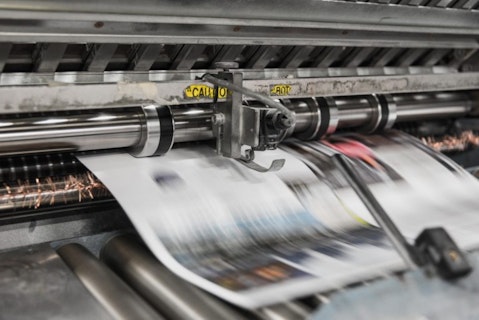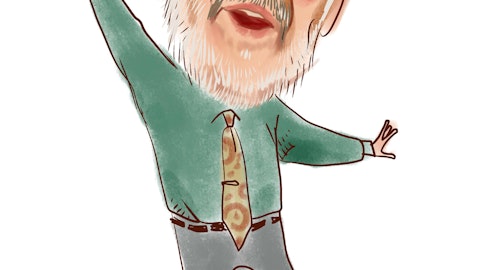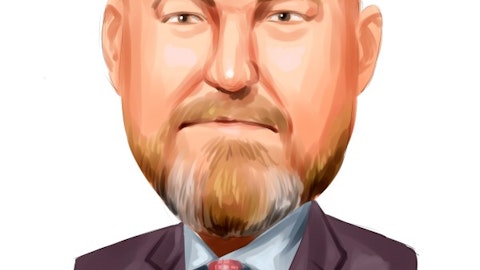Independent Bank Corporation (NASDAQ:IBCP) Q4 2022 Earnings Call Transcript January 26, 2023
Operator: Welcome and thank you for joining the Independent Bank Corporation 2022 Fourth Quarter and Full Year Earnings Call. At this time, all participants are in a listen-only mode. A brief question-and-answer session will follow the formal presentation. Now let me turn the call over to Brad Kessel, President and CEO. So Brad, you may begin.
William Kessel: Good morning, and welcome to today’s call. Thank you for joining us for Independent Bank Corporation’s conference call and webcast to discuss the company’s fourth quarter and full year 2022 results. I am Brad Kessel, President and Chief Executive Officer, and joining me is Gavin Mohr, EVP and Chief Financial Officer; and Joel Rahn, Executive Vice President, Commercial Banking. Before we begin today’s call, I would like to direct you to the important information on Page 2 of our presentation, specifically, the cautionary note regarding forward-looking statements. If anyone does not already have a copy of the press release issued by us today, you can access it at the company’s website, independentbank.com. The agenda for today’s call will include prepared remarks, followed by a question-and-answer session and then closing remarks.
Independent Bank Corporation reported fourth quarter 2022 net income of $15.1 million or $0.71 per diluted share versus net income of $12.5 million or $0.58 per diluted share in the prior year period. This represents increases in net income and diluted earnings per share of 20.6% and 22.4%, respectively, over the fourth quarter of 2021. For the fourth quarter of 2022, we generated an annualized return on average assets and return on average equity of 1.21% and 17.94% respectively. For the full year December 31, 2022, the company reported net income of $63.4 million or $2.97 per diluted share compared to net income of $62.9 million or $2.88 per diluted share in 2021. Our fourth quarter performance capped a very strong year as our entire organization executed extremely well despite a macroeconomic environment with many challenges and uncertainties.
This past year, with our successful expansion into new markets, in addition of new banking talent, we were able to generate strong commercial loan growth and higher net interest income, which enabled us to offset a significant decline in mortgage banking revenue and deliver a higher level of earnings in 2022 than we did in 2021. These full year results generated a return on average assets and return on average equity of 1.31% and 18.41%, respectively. Importantly, we have generated significant growth in our loan portfolio while maintaining sound underwriting criteria, a low level of past dues and net recovery is credited to our allowance in 2022. We continue to see positive trends during the fourth quarter, including double-digit annualized growth in our commercial loan portfolio and further expansion in our net interest margin.
Independent Bank has grown to $5 billion in assets as of year-end ’22 as compared to $4.7 billion as of December 31, 2021. Our current position in our markets has had a positive impact on business development, as we consistently see more commercial clients wanting to do business with a local bank that offers superior level of responsiveness and customer service while also having the size and scale to meet larger financing needs. Given the health of our loan portfolio and our high level of liquidity and reserves, we believe we are well positioned to continue effectively managing through the challenging and uncertain economic environment that we’re presently in and delivering strong results for our shareholders as we continue to leverage the investments we have made in banking talent and technology over the last several years.
During the fourth quarter, our total deposits grew to $4.38 billion from $4.33 billion the prior quarter end. Of that $4.38 billion, we consider $3.85 billion to be core. During the fourth quarter, we did see a decline in our core balances of $91.7 million. We believe a good portion of the decline to be seasonal, but also some movement related to the competitive market conditions. For the quarter, total cost of deposits increased from 0.33% to 0.77%. For the full year, total deposits increased by $295 million, of which $53 million is core. Stated another way, our core deposits increased for all of ’22 by 1.4%. We have included in our presentation a historical view of our cost of funds as compared to the Fed funds spot rate and the Fed effective rate from the last rate hike cycle through the most recent quarter end.
It may or may not be indicative of what we see prospectively, but does provide a good historical view of our company and its cost of funds during a rising rate environment. Through year-end, our beta for the cycle to date is 16.2%. We are currently forecasting a 50 point hike in February, a 25 basis point hike in March and then 25 basis point cuts in September and December of this year. Given the more competitive market, we are now seeing for deposit pricing, we estimate a higher beta with future rate hikes. At this time, I’d like to turn the presentation over to Joel Rahn to share a few comments on the success we’re having and growing our loan portfolios as well as provide an update on our credit metrics.
Joel Rahn: Thank you, Brad. On Page 7, we provide an update of our well-diversified loan portfolio. Total loans increased $55.4 million in the fourth quarter, led by our commercial portfolio, which increased $58.6 million. This continues our trend of strong quarterly commercial loan growth. For the year, our commercial portfolio increased $263 million or 22%, as a strategic expansion of our commercial banking team as well as marketplace disruption positively impacted growth. While moderating slightly in the fourth quarter, we see low double-digit commercial loan growth continuing into 2023 based on a solid pipeline and our continued focus on adding talent to our commercial banking team. In terms of residential activity, despite the headwinds of higher interest rates, our mortgage portfolio increased by $13.5 million in the quarter.
For the year, our mortgage portfolio grew $228 million. Consumer installment lending softened in the quarter as we have strategically pulled back in that area, that portfolio declined $16.7 million in the quarter. For the year, we grew our consumer loan portfolio $68.3 million. Overall, we are extremely pleased with our loan growth and believe we are on track to continue our planned asset rotation from the investment portfolio to higher yielding loans into 2023. On Page 8, we provide detail of our $1.47 billion commercial loan portfolio. C&I lending continues to be our primary focus, representing 64% of the portfolio. Manufacturing is the largest concentration within the C&I segment, comprising approximately 11% or $157 million. The remaining 36% of the portfolio is comprised of commercial real estate with the largest concentrations being industrial at $124 million or 8.5% and retail at $118 million or 8%.
It’s worth noting that of the $662 million of new commercial loan volume generated in 2022, $411 million or 62%, with C&I versus $251 million or 38% investment real estate. By design, this portfolio is very granular in nature, and we’re maintaining our credit discipline to ensure that we maintain good diversity in this portfolio. Page 9 provides an overview of key credit quality metrics at 12/31. Total non-performing loans were $3.7 million or 0.1% of total loans at year-end. Loans 30 days to 89 days delinquent totaled $3.1 million at 12/31, up slightly from the third quarter, primarily due to an uptick in consumer loan delinquency. At this time, I’d like to turn the presentation over to Gavin for his comments, including the outlook for the remainder of the year.
Gavin Mohr: Thanks, Joel, and good morning, everyone. I’m starting at Page 10 of our presentation. Page 10 highlights our strong regulatory capital positions. The CET1 ratio and the total risk-based capital ratio increased in the fourth quarter of 2022. Net interest income increased $6.3 million from the year ago period. Our tax equivalent net interest margin was 3.52% during the fourth quarter of 2022, which is up 39 basis points from the year ago period and up 3 basis points from the third quarter 2022. I’ll have some more detailed comments on this topic in a moment. Average interest earning assets were $4.64 billion in the fourth quarter of 2022 compared to $4.43 billion in the year ago quarter and $4.61 billion in the third quarter of ’22.
Page 12 contains a more detailed analysis of the linked quarter increase in net interest income and the net interest margin. Our fourth quarter 2022 net interest margin was positively impacted by two factors, increase in yield on investments at 13 basis points and change in loan yield and mix of 36 basis points. These increases were partially offset by an increase in funding cost of 46 basis points. We will comment more specifically on our outlook for net interest income and net interest margin for 2023 later in the presentation. On Page 13, we provide details on the institution’s interest rate risk position. The comparative simulation analysis fourth quarter ’22 and third quarter ’22 calculates the change in net interest income over the next 12 months under 5 rate scenarios.
All scenarios assume a static balance sheet the base rate scenario applies the spot yield curve from the valuation date. The shock scenarios consider immediate permanent and parallel rate changes, the decrease in the base rate forecasted net interest income in fourth quarter ’22 compared to third quarter ’22 is primarily due to an adverse shift in the funding mix in a higher than modeled betas on interest-bearing deposits during the quarter. These changes were partially offset by earning asset growth and a favorable change in earning asset composition. The shift in sensitivity is primarily due to faster liability repricing due to a shift in the funding mix with the decline in less sensitive DDA and savings deposit and an increase in wholesale funding.
Currently 28% of assets repriced in one month and 41.3% reprice in the next 12 months. Moving on to Page 14. Non-interest income totaled $11.5 million in the fourth quarter of ’22 as compared to $15.8 million in the year ago quarter and $16.9 million in the third quarter of ’22. Fourth quarter 2022 net gain on mortgage loans totaled $1.5 million compared to $5.6 million in the fourth quarter of ’21. The decrease in these gains was due to a decrease in mortgage loan sales volume and in the mortgage loan pipeline as well as lower loan sale profit margins. Mortgage loan applications have slowed and the mortgage production mix has rotated to a lower percentage of salable mortgages positively impacting non-interest income was $0.7 million gain on mortgage loan servicing due to $2.2 million of revenue that was partially offset by a $0.5 million or $0.02 per diluted share after tax decrease in the fair value due to price and a $1 million decrease due to paydowns of capitalized mortgage loan servicing rights in the fourth quarter of 2022.
As detailed on Page 15, our non-interest expense totaled $31.5 million in the fourth quarter of 2022 as compared to $34 million in the year ago quarter and $32.4 million in the third quarter of 2022. Compensation increased $1.3 million compared to the prior year quarter due to raises that were effective at the start of the year, a decreased level of compensation that was deferred in the fourth quarter of ’22 as direct origination costs on lower mortgage loan origination volume and an increase in lending personnel. Performance-based compensation decreased $0.3 million due primarily to a decrease in mortgage lending volume and lower performance level within the corporate incentive compensation plan compared to fourth quarter ’21. The fourth quarter of ’22 included a $0.7 million credit to the expense related to the reserve for unfunded lending commitments due to a decrease in volume of such lending commitments as well as the expected loss rate.

Photo by Bank Phrom on Unsplash
Other expenses decreased $6 million compared to the prior year quarter, primarily due to a lower fraud related losses as well as contract termination costs incurred during the prior year quarter. We will have more comments on our outlook for non-interest expense later in the presentation. Page 16 is our update for — our 2022 outlook to see how our actual performance during the fourth quarter compared to the original outlook that was provided in January of 2022. Our outlook estimated loan growth in the low-double digits. Loans increased $55 million in the fourth quarter of 2022 or 6.5% annualized and $560.3 million or 19.3% for the full year 2022, which is above our forecasted range. Commercial mortgage loans had positive growth in the fourth quarter of ’22, while installment loans decreased.
Fourth quarter 2022 net interest income increased by 18.4% over 2021, which is higher than our forecast of low-single digit growth. The net interest margin for the fourth quarter of 2022 was 39 basis points higher than the fourth quarter of 2021. Net interest margin of 3.13%, which is higher than our original forecast. Actual results benefited from a notable increase in interest rates during 2022. The fourth quarter 2022 provision for credit losses was an expense of $1.4 million or 16 basis points annualized. This is within our forecasted 2022 full year provision range of 15 basis points to 20 basis points of average total portfolio loans. The primary driver of the increase in the provision for credit losses was an increase in subjective (ph) allocations related to general economic conditions.
Non-interest income totaled $11.5 million in the fourth quarter of ’22, which below our forecasted range of $13 million to $17 million. Fourth quarter 2022 mortgage loan originations, sales and gains totaled $138.9 million, $80.6 million and $1 million, respectively. The decrease in net gains on mortgage loans sold was primarily due to lower sales volume and decreased profit margin on mortgage loan sales. Mortgage loans servicing generated a gain of $0.7 million in the fourth quarter of ’22. Non-interest expense was $31.5 million in the fourth quarter within our forecasted range of $30.5 million to $32.5 million targeted quarterly. Our effective income tax rate of 18.9% for the fourth quarter of 2022 was at the lower end of our forecasted range.
Lastly, we purchased 181,586 shares at an average cost of $22.08 for the year-to-date period in 2022. Turning to Page 17. This will summarize our initial outlook for 2023. The first section is loan growth. We anticipate loan growth in the low-double digit range, and are targeting a full year growth rate of 10% to 12%. We expect to see growth in commercial and mortgage loans with installment loans remaining flat. This outlook assumes a stable mission (ph) economy. Next, is net interest income, where we are forecasting growth rate of 7% to 9% over the full year 2022. We expect the net interest margin to be stable — to slightly higher compared to full year 2022 by 5 basis points to 10 basis points, primarily due to increasing yields on earning assets.
This forecast assumes a 50 basis point increase in February, a 25 basis point increase in March, followed by a 25 basis point decrease in both September and December and the target Fed fund rate in 2023 with long-term rates declining slightly by year-end. A full year 2022 provision expense for allowance for credit losses of approximately 0.25% to 0.35% of average portfolio loans would not be unreasonable. Related to non-interest income we estimate a quarterly range of $11 million to $13 million. We expect mortgage loan origination volumes to decline by approximately 20% in 2023. Our outlook for noninterest expense is a quarterly range of $32 million to $33.5 million, with the total — for the year 1.5% to 2.5% above the 2022 actuals. The primary driver is an increase in data processing and FDIC deposit insurance premiums.
Our outlook for income taxes is an effective rate of approximately 18.8%, assuming the statutory federal corporate income tax rate does not change during 2023. Lastly, the Board of Directors authorized share repurchases of approximately 5% in 2023. Currently, we are not modeling any share repurchases in 2023. That concludes my prepared remarks, and I’d like now to turn the call back over to Brad.
William Kessel: Thanks, Gavin. Each quarter, we share a high level view of our key strategic initiatives as we head into 2023. Our focus will continue to be on the rotation of our earning asset mix of lower yielding investments into higher yielding loans, growing our deposit base, while managing our cost of funds and controlling our non-interest expenses. While there is an increasing concern about a potential economic slowdown, at this point, we continue to see healthy economic conditions and loan demand in Michigan. We’re excited about the opportunities we have to continue to grow — continue our growth trends into 2023. We built a strong franchise based on a talented team, a low-cost deposit base and well-diversified loan portfolio, which we believe positions us well to effectively manage through a variety of economic environments and continuing to deliver strong results for our shareholders. At this point, we’d now like to open up the call for questions.
See also 12 Best Performing S&P 500 Stocks in the Last 5 Years and 11 Best American Oil Stocks To Buy.
Q&A Session
Follow Independent Bank Corp (NASDAQ:IBCP)
Follow Independent Bank Corp (NASDAQ:IBCP)
Operator: Thank you. . We’ll have our first question from the line of Erik Zwick of Howard Group. Please go ahead, when you are ready.
Erik Zwick: Good morning, everyone.
William Kessel : Good morning.
Gavin Mohr: Hi, Erik.
Erik Zwick: First, I just wanted to start on the net interest margin. The guide for ’23 would imply some compression here from the 4Q ’22 level. So just curious how you might expect that to trend throughout the year. If it would be some of that compression front-loaded just as the deposit cost catch up. And then if the Fed stops it’s hiking campaign towards the middle of the year with the compression potentially be slower in the back half of the year or do you expect it to be kind of more even just curious maybe talk on that topic.
Gavin Mohr: Yeah, Eric. This is Gavin. You explained it very well. So the first part of the year, we do believe we’ll see some compression. And then with the rate forecast we’ve utilized, there would be stabilization midyear, potentially slight expansion at the back end.
Erik Zwick: Okay. Great. And then with respect to the investment securities portfolio, I think I heard you mention there’s still opportunities to optimize the entire asset mix. So just curious how you would expect the size of the securities portfolio to trend throughout the year, either in terms of kind of dollar amount or percentage of total assets, how it could look at the end of ’23.
Gavin Mohr: Yeah. Current modeling speeds, Eric, we’re looking at about $170 million of run-off next year.
Erik Zwick: Okay. Thank you. I appreciate that. And then in terms of the non-interest expenses that you mentioned in the presentation on some opportunities to gain additional efficiencies as you optimize delivery channels. Curious, if you could talk to maybe any specific projects, either and that have been implemented today or others you might expect to initiate in 2023?
William Kessel: Sure, Eric. This is Brad. And point your attention back to when we did our core conversion in May of ’21. And here we are now coming up almost on the second year anniversary date post conversion. And we continue to see opportunities for efficiencies with that conversion. So in 2022, we had quite a bit of savings in the FTE count within the — in the branch network. And I think there’s the opportunity there also just as we have vacancies not having to replace those as well as in the back room where we’re just not touching the paper like we did previously. So those are a couple of areas that we think there’s opportunity.
Erik Zwick: Okay. And then last one for me. You spoke to a little bit in terms of the loan growth and the outlook for 10% to 12% led primarily by commercial installment loans flat. I’m curious maybe from a geographic perspective, if there’s any particular markets that are stronger today that you expect to drive that growth more relative to others in the coming year?
William Kessel: Well, I can take a high level and then I probably — Joel, why don’t you go first? Go ahead.
Joel Rahn: Yeah. Well, I think it’s pretty straightforward, answer. I’ll frame it up by saying in 2022, we had good growth in our entire footprint. All of our regions contributed, but there’s no question that our two largest markets, Southeast Michigan and West Michigan are driving a lot of our growth, and we see that continuing. So Southeast Michigan and West Michigan are our two most active growth markets.
Erik Zwick: Great. Thank you for taking my question today.
William Kessel: Thank you.
Operator: Your next question comes from the line of Mat Renck of KBW. Please go ahead, when you are ready.
Matthew Renck: Hi, guys. This is Matt Renck filling in for Damon DelMonte. I hope everybody is doing well. With respect to credit, just curious if you’re seeing any signs of stress within any of your loan categories? And then more specifically, with regards to the office portfolio, you just provide some more color about what type of exposure you have to office and how those loans are performing?
Joel Rahn: Hi. This is Joel. In terms of just the overall credit quality, no broad trends that we’re seeing. We’re seeing a little bit of stress in the manufacturing sector, with just upward rising price cost of manufacturing products due to increased wages and raw material price inflation. But again, there’s not a broad theme to it. We’re just seeing isolated cases of that. But we continue to watch that carefully. And then in terms of office exposure, we’ve got about $81 million. It’s shown on Page 8. It’s about 5 point — about 5.5% of our portfolio in office. And I would characterize our office exposure as primarily suburban, low rise and with a fair amount of medical office usage. So we actually feel very good about our office exposure in our portfolio. It’s held up extremely well.
William Kessel: Yeah, Joel. I’d add over on the consumer side, we continue to watch closely, but are not seeing any early signs of stress there.
Matthew Renck: Got it. Great. Thank you for the color. And then just one follow-up to Eric’s question about loan growth. Are you planning any new additions of commercial bankers or expansions into new markets?
Joel Rahn: Yeah. I think we are continually recruiting additional commercial banking talent probably the best way I would answer that. So that will just be an ongoing strategy for us or focus and that’s what we’ve got built into the ’23 plan.
Matthew Renck: Got it. Great. Thank you for taking my questions.



